After a good night's sleep, I could get up early
The sun was coming up

I could take a good look at where our hotel was: right at the side of a park

It was a cloudy day

Our breakfast room
After breakfast, I took a look around: the hotel lobby
An unusual angle on one of the lobby walls

the decorations on the first floor conference hall
seeds
chillis
Mushrooms

Bikes outside the hotel
We were taken to see the most famous church in the city : the Alexander Nevsky Cathedral (Bulgarian: Храм-паметник „Свети Александър Невскиbuilt) built in the Revival Style of the Bulgarian Empire. After gaining independence in 1878, the Bulgarian Constitutive National Assembly decided to build the cathedral to commemorate St. Alexander Nevsky (Sveti Aleksandar Nevski), the patron of the Tsar-Liberator's victory over the Teutons near Lake Ladog. Though its corner stone was laid in 1882, serious work on it was done between 1904-1912. It was completed in 1916 and sanctified in 1924. It was designed by architect Alexander Pomerantsev, assisted by Alexander Smirnov and Alexander Yakovlev and a team of Bulgarian, Russian, Austro-Hungarian and other European artists, architects and workers. Built in the neo-Byzantine style, it was intended to recall Instanbul's Hagia Sophia. It has a bell tower in 174 feet and 12 bells weighing 23 tons, the heaviest weighing 12 tons and the lightest 22 pounds. It was decorated with the help of the best Soviet artists. It's the Bulgarian Orthodox cathedral in Sofia, the capital of Bulgaria and is one of the largest Eastern Orthodox cathedrals in the world and the second-largest cathedral on the Balkans, after the Cathedral of Saint Sava in Belgrade as well as one of Sofia's symbols and primary tourist attractions. It covers an area of 34,100 sq ft and can hold 10,000 and has a cross-domed basilica featuring an emphasized 148-feet central dome, which has the Lord's prayer inscribed on it in gold. Its interior is decorated with Italian marble in various colours, Brazilian onyx, alabaster, and other luxurious materials. Saint Alexander Nevsky was a Russian prince who helped Bulgaria gain independence from the Ottoman Turks during the Russo-Turkish War of 1877-1878 and the cathedral was also built in memory of the Russian soldiers who died during that war. The marble parts and the lighting fixtures were created in Munich, the metal elements for the gates in Berlin, while the gates themselves manufactured in Vienna and the mosaics shipped from Venice.The name of the cathedral was briefly changed to the Sts. Cyril and Methodius Cathedral between 1916-1920 (because Bulgaria and Russia were then on opposite sides in WWI), but when hostilities ceased, its initial name was restored. The cathedral was proclaimed a cultural monument on 12 September 1924. On the left of the altar,there is a case displaying a fragment of the rib of Alexander Nevsky as the church's relic, a gift of the Russian Orthodox Church.
Some of the domes

A front view of the church
Then we were led to its vicinity
The city lion
A memorial to the bishop who led the efforts in the building of the cathedral

St. Alexander Nevsky
St. Sophia
The local bishop
There is a crypt beneath the church which used to house the tombs of high ranking priests of the church but since 1965, had been turned into a museum of old Bulgarian art with the largest collection of icons in the Balkans
A window of the cathedral
The streets were wide
This is the Bulgarian Parliament
This is the Academy of Science but it's facing financial difficulties because the government refuses to continue to pay subsidies for its functioning.
This is the police headquarters, if I remember correctly. After this brief tour of an hour and a half, we are on our way again because we got to travel 260 km that day.
A supermarket opposite our rest stop
Aerodium, whatever that is. I asked the guide, he didn't know either.
right next to rest stop, there's a tyre changing facility
The tyres were really huge
this is how they move them around
This is how they move trucks
Magazine cover of Biorap
Another magazine cover
One of the tour group members would take at least a beer at every rest stop
All kinds of beers are available for truckers
and not just beers
white wines
red wines, whiskeys
rosé, port, sherry, rum, vodka
We're off again

it was a cloudy day
we passed through more hills and tableland
But mostly rolling plains
Some of the crops have been harvested, leaving behind old stalks
Time for lunch again at Veliko-Turnovo
Plenty of wine samples on the staircase landing

A painting on the wall
We could a get a view of the River Yantra below
A closer view of the river
Veliko Turnovo is built on the hillside
Our starters
Bulgarian pizza
Our guide
The two cooks who prepared the pizza with log-wood fire
Dishes ready to serve
Our dessert
beans and pasta for window decoration!
Time to go
The road to our hotel
The main road to the Veliko (or great) Tarnovo (Bulgarian: Велико Търново, ), a town of about 100,000 in north central
Bulgaria and the administrative centre of Veliko Tarnovo Province, frequently called the "City of the Tsars", located on the
Yantra River, is famous as the historical capital of the Second
Bulgarian Empire. The old part of the city is situated on the three hills Tsarevets,
Trapezitsa, and Sveta Gora rising amidst the meanders of the Yantra.
This is the commercial heart of the town
All sorts of old fashioned wares on sale
As it was a small town, no much attention is paid to presentation
An interesting display outside of a shop
native arts and crafts for sale
woodcraft for sale
colorful ladles and cow bells
a local family coming out of a local fast food shop
copper Turkish coffee pots
charms hung on a local tree branch
A mural in the street
Another mural
The winding road up the Tarnovo Castle on the Tsarevets where the old palaces of the Bulgarian emperors and the Patriarchate, the Patriarchal Cathedral, as well as a number of administrative and residential edifices were built, surrounded by thick walls. Trapezitsa is known for its many churches and as the former main residence of the nobility. In the Middle Ages, the city was among the main European centres of culture and gave its name to the architecture of the Tarnovo Artistic School, painting of the Tarnovo Artistic School and literature. Veliko Tarnovo is an important administrative, economic, educational, and cultural centre of Northern Bulgaria. The original names Tarnovgrad and Tarnovo come from the Old Bulgarian тръневъ (tranev) or тръновъ (tranov), meaning "thorny". The suffix "grad" means "city" in Bulgarian and in many Slavic languages. In 1965, the word велико (veliko) (meaning "great")was added, in honour of the city as an old capital of Bulgaria. But Tarnovo remains the most used name by the locals.Veliko Tarnovo has a history of more than five millennia, the first traces of human presence on Trapezitsa Hill dating from the 3rd millennium BC . Between the 12th and 14th centuries in the middle ages, it grew quickly into the strongest Bulgarian fortification and the most important political, economic, cultural and religious centre of the empire.As the Byzantine Empire weakened in the 14th century, Tarnovo prided itself as the Third Rome based on its preeminent cultural influence in Eastern Europe. As the capital of the Second Bulgarian Empire, Tarnovo was a quasi-cosmopolitan city, with many foreign merchants and envoys including Armenian, Jewish and Roman Catholic ("Frankish") merchant who had their own quarters besides a dominant Bulgarian population. The discovery of three Gothic statuette heads indicates there may have also been a Catholic church.In 1393, Tarnovo was seized by the Ottoman Turks and the whole Bulgarian Empire collapsed. Many Bulgarian towns and villages,
monasteries and churches were burnt down. Under Ottoman rule, the town was renamed Tırnova. It revolted twice, the first in 1598 (the First Tarnovo Uprising) and
1686 (the Second Tarnovo Uprising) but both failed to throw off Turkish rule. Tarnovo was at first made a district (sanjak) centre of Rumelia
Eyalet, after that of Silistria Eyalet and finally of Danube Vilayet
before becoming part of the Principality of Bulgaria. It remained under Turkish rule until the 19th century, when national identity and culture reasserted themselves and the town revolted in 1875 and 1876 . On 7 July 1877, Russian general Joseph Vladimirovich Gourko liberated
Veliko Tarnovo, ending the 480-year-rule of the Ottoman Empire. In 1878, the Treaty of Berlin created a Principality of Bulgaria
between the Danube and the Stara Planina range, with its seat at this town. On 17 April 1879, the first National Assembly convened in Veliko Turnovo
to ratify the state's first constitution, known as the Tarnovo
Constitution, transferring the Parliament from Tarnovgrad to Sofia. In deference to the city's past, Tsar Ferdinand Saxe-Coburg Gotha chose
the St Forty Martyrs Church in Veliko Tarnovo as the place to declare
the complete independence of Bulgaria on 5 October 1908.In 1965, the city, then officially known as Tarnovo, was renamed to
Veliko Tarnovo (Great Tarnovo) to commemorate its rich history and
importance.Today the town is undergoing extensive construction, including
reconstruction of the old city and some of the buildings on historical
streets. The two universities, the American University and Agriculture
University give the town a youthful and educated feel. The city also
hosts many culture activities such as music from Bulgarian and foreign
singers, theater, and festivals. Today the town is also one of
Bulgaria's biggest manufacturers of sweets. 96% of its population are Bulgarians.
In the distance we can see Patriarchal Church
The entrance to the Tarnovo Castle
The coat of arms of old Tarnovo
The walls of the castle extended for many miles
Going up to the heart of the castle
Medieval weaponry
The left bank of Yantra River
The right bank of the Yantra River
Both sides of the Yantra River
Bells on top of the Trapezitsa
The city walls can be clearly seen
The path up the heart of the castle
A plan of the old castle
The high castle walls
A part of the castle
A little girl trying to look through the telescope
The newer part of the town
The old palace

The old palace from another angle
A full view of the old palace
The clouds above the castle
The old cathedral
The site of the old palace
A closer view of the old palace
The palace from another angle
The Yantra River from a different angle
The Cathedral from a different angle
The former palace
The two levels of the castle
The entrance to the old castle
The old palace from another angle
The Yantra River settlement
The plaza leading to the entrance to the castle
A panoramic view of the old castle
One of the houses in an alley
grapes in the street
Rows of shops
A shop window
A tiger?
A hippo
A chicken
Shoulder bag
scarves
wool dolls
A woodcutter
cockerels in wood
Cermaics
More ceramics
leather bird
leather cat
leather pig/elephant
ceramic pear
More ceramic fruits
bronzes
A tropical lady
a painting
portrait of the town
a religious painting
An abstract painting
handmade pasta
notice for genuine handmade pasta
Sex shop display
More of the same
decoration in front of a shop
Roadside flowers in purple
More roadside flower in red
roadside flower in orange and red
Roadside flowers in purple
Roadside flowers in red
roadside flower in white
A rare combination of colors
a threesome
A colorful house
Another part of main road
narrow cobbled stone street
murals
Graffiti
More graffiti
More graffiti
graffiti on the steps
More graffiti on the steps
More of the same
A different style
graffiti in front of a shop
Graffiti on a peeled off wall
Another graffiti
garbage bins
The monument to Ascenevci on the other side of town
Another view in perspective
Some of the shops are empty
Some of the houses are dilapidated
An abandoned shop
Some blue strings are left
a window is painted
a peeling wall
An old fashioned shop sign
An old fashioned door rapper
steps going down between two houses
The town library
The corridor outside the library
The houses on a quiet side street
Cathedral of Kolyo Ficheto for Birth of Theotokos completed 1844 and rebuilt 1913.

front view of the church
a view of the church from a different side
Who is this with a gun in his hand? One of the 40 martyrs who died defending the city in the revolt of 1875 or 1876?
a log cabin close to the church overlooking the Yantra valley below
two children playing in front of the church
The entrance to our restaurant
Our restaurant
The same street after dark
Children's playground at night
The town at night
illuminated decorations
A display in front of the entrance to some houses
A main road at night

The independence monument in front of our hotel

















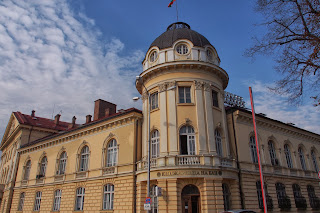

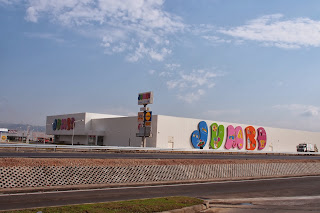




























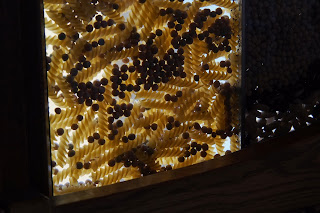


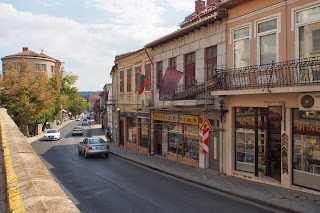




























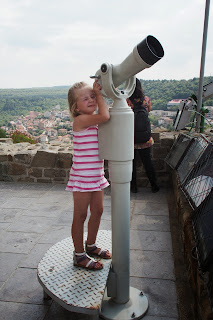































































































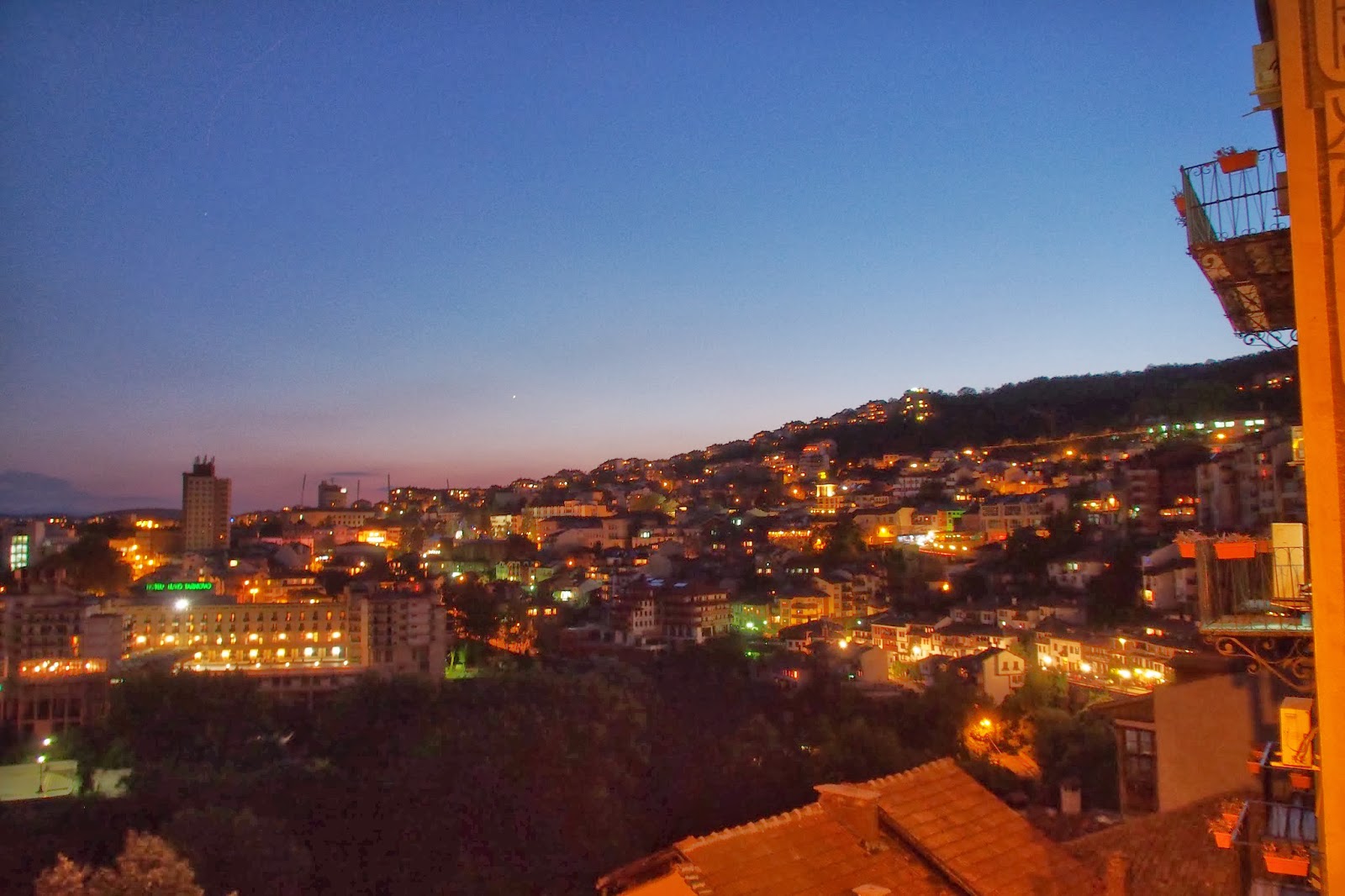



沒有留言:
張貼留言